|


Germany (1916)
Sources:
Karl-Heinz Luchs (nephew) / Neuß
Photo album of Peter Bürvenich
|
Hans Luchs was born on 29 March 1916 in Düsseldorf as the third and youngest son of Jakob and Anna Luchs. At the time of Hans’s birth, Jakob 34, was a swimming pool supervisor in Neuss, near Düsseldorf. Because of the father’s job, Hans and his two older brothers Willi (born 1913) and Franz (born 1915) were active in sports. In 1920 the family moved to Neuss across the Rhein River. At Easter two years later Hans Luchs started school at the local Catholic elementary school. He got his certificate in 1930, and like his brothers, decided to learn a skilled trade. One brother was a house painter, the other an electrician. Hans started job training as a metal worker at the Heinrich Frank & Söhne metalworking shop. In 1933 he finished training and stayed at the shop as a journeyman. He spent his free time swimming and playing soccer.
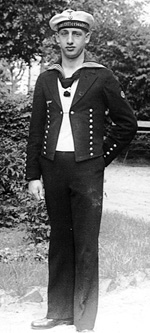 In 1934 Hans Luchs volunteered for the Kriegsmarine. Hans, a winner of the National Sport Badge, passed the physical examination with flying colors. And, after further successful tests, he was accepted. On 24 June 1935 the 19-year-old Hans reported to basic training in a coastal artillery unit. Near the end of basic training, he was assigned to the biggest and told to report to the pocket battle ship Admiral Graf Spee. With her sister ships Admiral Scheer and Deutschland, Graf Spee was the largest and most modern ship in the Kriegsmarine. Work on the ship was still in progress as Hans set out for Wilhelmshaven on 27 September 1935.
In 1934 Hans Luchs volunteered for the Kriegsmarine. Hans, a winner of the National Sport Badge, passed the physical examination with flying colors. And, after further successful tests, he was accepted. On 24 June 1935 the 19-year-old Hans reported to basic training in a coastal artillery unit. Near the end of basic training, he was assigned to the biggest and told to report to the pocket battle ship Admiral Graf Spee. With her sister ships Admiral Scheer and Deutschland, Graf Spee was the largest and most modern ship in the Kriegsmarine. Work on the ship was still in progress as Hans set out for Wilhelmshaven on 27 September 1935.
During a brief stay in Lübeck, he wrote his family and proudly told them about his new command. At the shipyard, he began technical indoctrination classes to familiarize himself with the Spee’s sophisticated modern diesel motors.
|
|
|
|
Picture gallery – Hans Luchs
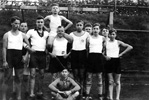



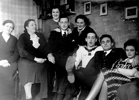
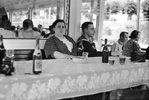
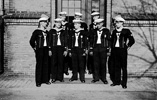
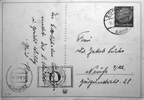
Click on the pictures to enlarge.
On 6 January 1936 the Admiral Graf Spee was commissioned and made tests runs in the Jade Bay until mid April before joining the fleet and replacing the old ship of the line Schleswig-Holstein as fleet flagship. In June 1936 Hans experienced his first deployment abroad sailing to field exercises near the Canary Islands. Shortly afterwards, Graf Spee was sent on her first mission to Spain, where the Spanish Civil war was underway. The ship was deployed to the Spanish Mediterranean coast another four times. However, Hans did not take part in all four deployments.
Hans liked duty in the Kriegsmarine, especially the travelling. “The world is beautiful; you just have to get to know it first,” he wrote his family from Flensburg in 1938. In the meantime, he had been promoted to Stoker 1st Class, and since his superiors were impressed by his efficiency, he was selected to be an NCO candidate. After a leave in the summer of 1938, he started his general NCO training with the 2nd Company of the 1st Naval NCO Section in Kiel-Friedrichsort. After graduating as a Machinist’s Mate, he was assigned to duty first with the 1st Training Division in Kiel, then with Engine Training Phase III at the Navy School (Marineschule) in Kiel the spring of 1939. After graduation, Hans was assigned to the Naval Office (Kriegsmarinedienststelle) in Hamburg before going to the Bismarck, which had been launched in February and was still not completed. He joined the skeleton crew which was to begin the construction training and instruction on the ship.
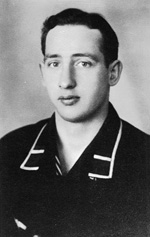 In March of 1940 Hans experienced a real highlight when he travelled with a group of machinists and machinist’s mates on a two-week inspection trip to several of the ancillary industries located throughout Germany. They first flew to Dresden where they visited and observed the construction and assembly of several engines produced for the ship. They also went to Nuremburg, Mannheim and Berlin. Hans was thrilled. “A trip like this is really wonderful,” he wrote on a postcard to his mother from Nuremburg.” The group returned to Hamburg and continued completing the construction. In August 1940, the Bismarck was commissioned, and the construction training and instruction phase ended. As part of Division 10, Hans took over a platoon which pulled duty in one of the service rooms of the huge power plant. While underway to the first sea trial in The Baltic Sea, the Bismarck put in to the Scheerhafen in Kiel where Hans and his platoon celebrated the occasion.
In March of 1940 Hans experienced a real highlight when he travelled with a group of machinists and machinist’s mates on a two-week inspection trip to several of the ancillary industries located throughout Germany. They first flew to Dresden where they visited and observed the construction and assembly of several engines produced for the ship. They also went to Nuremburg, Mannheim and Berlin. Hans was thrilled. “A trip like this is really wonderful,” he wrote on a postcard to his mother from Nuremburg.” The group returned to Hamburg and continued completing the construction. In August 1940, the Bismarck was commissioned, and the construction training and instruction phase ended. As part of Division 10, Hans took over a platoon which pulled duty in one of the service rooms of the huge power plant. While underway to the first sea trial in The Baltic Sea, the Bismarck put in to the Scheerhafen in Kiel where Hans and his platoon celebrated the occasion.
The last the Luchs family heard from Hans was a postcard he sent from Zoppot near Gotenhafen. Over Easter weekend in 1941 the Bismarck put in to Gotenhafen, and Hans and several friends went to the nearby beach resort. Several weeks later the Bismarck put out to sea. Machinist’s Mate Hans Luchs, 25 years old, went down with the Bismarck on 27 May 1941.
|
|